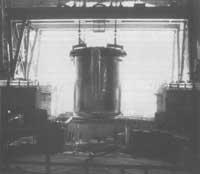Superphenix: Many millions to grains? What is going!
The security of nuclear power plants is a highly debated issue. In the Soviet Union and the United States, they have known very well what is the leak of a nuclear power plant. Most existing nuclear power plants in the Spanish state have had so-called technical stops. But often it is not known why technical stops. In France the technical stop was on the road to being definitive, but finally the monster has resurfaced.

Superphenix is a large power experimental model (1200 MW). The reactor is quick neutron. The rest of nuclear power plants manufactured so far in France have been damped with water. The difference between these two types of power plants lies in the site configuration. Conventional power plants consume uranium, but only a small part of the uranium causes fission. In the area of the superphenix is the plutonium, which is covered with uranium. Uranium was believed to become plutonium. Therefore, the benefit obtained from uranium is better in this case than in the previous one.
The shortage of oil and uranium caused the emergence of these new nuclear power plants. After connecting to the Superphenix power grid (January 1986) it has produced the most expensive electricity in France; kilowatio. the cost of the hour has been twice that of the conventional nuclear power plant. According to researchers, costs will be reduced by 30% in the future, but during technical stops it will be difficult to get a cheaper product.
On the other hand, the detected sodium leak has added great uncertainties to this project. But let's start counting from the beginning.
On April 3, 1987, an official announcement said: The Creys-Malville nuclear power plant in Isère loses sodium by drip.
Liquid sodium is used in a closed circuit to cool the area. It burns by contact with air and explodes in contact with water. A few drops of sodium can remove all water from a bath by an explosion. Circuits with sodium for this reason are covered with inert gas.
The leak did not occur in the reactor area, but in the adjacent cylindrical tank. The sodium leak was almost 40 liters per hour. Cylindrical tank 13 m high, 9.5 m in diameter, used as fuel tank of the area. Fuel loading and unloading takes place every 14 months. The radioactive fuel remains approximately one year in this tank until the temperature and radioactivity rate decreases slightly.
Inside this cylinder the fuel is placed in a tiovivo device. The cylinder has 700 tons of sodium inside and a double steel lid. The distance between the two covers is about ten centimeters and in that interval there is nitrogen.
When measuring the amount of sodium, it was noticed that there were between 15 and 20 m3. This sodium was found in the aforementioned section. After more thorough studies it was determined that the leak occurred throughout the month. The position of the fissure, on the other hand, made it very difficult to access a possible repair. Endoscopy was also done, but the error was not resolved.
Faced with this event there were many voices against nuclear power plants. In addition, in this particular case many questions have been asked and in most cases the answers have not been very clear.

The first concern arises from the time elapsed between the detection of the error and its prediction, which passed almost a month. According to the company the alarm worked correctly, but the operator did not give him importance, since the latter thought that the alarm was the same that worked badly.
However, there is another more serious concern, that is, was it dangerous for the reactor to function during the leak?
It is true that sodium did not come out of the cylinder. Therefore, the normal operation of the plant was not modified. However, the two cylinder walls were of the same material, specifically carbon steel, and if one of them presents manufacturing defects, the other, being of the same material, can keep them exactly the same. In this case sodium would be expelled out of the cylinder and contact with water and air would ensure the massacre. If the area is surrounded by stainless steel, it has been proven that if the defective cylinder was made in the same steel as the zone, it would be better.
This problem has not only occurred in the Superphenix but also in Bensberg (Germany) and Almeria (Spain).
Questions regarding cylinder contents did not have a clear answer. If sodium were radioactive, its explosive condition would become a source of radioactive contamination.
Two years after this event, Superphenix works again. On 12 January the French Minister of Industry, Roger Fauroux, said that the safety requirements for its operation have been met and two days later two boron bars were removed that impeded nuclear reaction and the plant was launched. Its current power is 130 MW, which means a maximum of 10% of what it can contribute.
The explanation given about the detected fissure of 46 cm has been as follows: the initial microfibers have increased with the one used.
No, nothing will happen, reader. Stay calm. But if tomorrow starts an alarm indicating another microfiber and...





